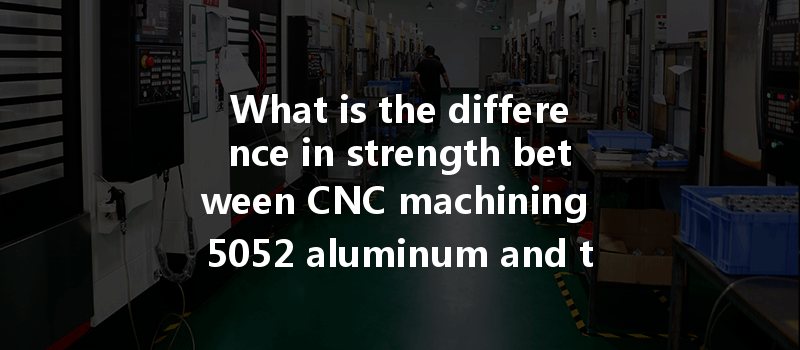Opening
Did you know that both aluminum and polycarbonate (PC) plastics have been pivotal in revolutionizing the manufacturing and design industries? While these materials have different properties and applications, their role in CNC (Computer Numerical Control) machining is critical, especially when it comes to strength. This blog dives deep into comparing the strength characteristics between CNC machining of 5052 aluminum and transparent PC plastic, exploring why understanding these differences matters in today’s manufacturing landscape.
—
Understanding 5052 Aluminum and Transparent PC Plastic
The Basics of 5052 Aluminum
5052 aluminum is renowned for its durability and corrosion resistance. It belongs to the 5000 series of aluminum alloys, primarily composed of magnesium as the alloying element. Its unique combination of properties makes it suitable for a wide array of applications, including automotive, marine, and general fabrication. With a yield strength that can reach up to 290 MPa, it is valued for its workability and formability, making it ideal for various machining processes.
The Fundamentals of Transparent PC Plastic
On the other hand, transparent polycarbonate plastic is celebrated for its exceptional toughness and transparency. Known for its high impact resistance and optical clarity, PC plastic is often used in applications needing visibility and strength, like safety goggles, eyewear, and even lenses. It exhibits a tensile strength of around 60 MPa, significantly lower than that of 5052 aluminum; however, its lightweight nature and versatility allow for unique capabilities in design and application.
—
Comparison of Strength Characteristics
Tensile Strength
One of the most crucial aspects of material selection in manufacturing is tensile strength, which measures a material’s ability to withstand tension or pulling forces. When comparing 5052 aluminum to transparent PC plastic, the difference is stark. The tensile strength of 5052 aluminum can exceed 290 MPa, while that of PC plastic hovers around 60 MPa.
This disparity means that aluminum is generally better suited for applications where higher strength and durability are required, especially in structural components. In contrast, PC plastic, despite its lower tensile strength, offers excellent impact resistance, making it suitable for protective applications.
Impact Resistance
While tensile strength is critical, impact resistance is another essential factor in determining the suitability of a material for specific applications. Transparent PC plastic consistently wins in this category. The unique properties of PC plastic allow it to absorb energy without cracking, while 5052 aluminum can deform or buckle under significant impacts.
This characteristic makes PC plastic the material of choice for applications like safety equipment and clear protective barriers, while 5052 aluminum is perfect for structural support where static loads are concerned.
Weight Considerations
Weight is also an important factor in material selection, particularly in industries like aerospace and automotive where reducing weight can lead to significant performance improvements. Transparent PC plastic is significantly lighter than 5052 aluminum, which is advantageous for applications where weight reduction translates into energy savings and improved efficiency.
Although 5052 aluminum is not excessively heavy, the ability to use transparent PC plastic for lightweight components can lead to innovative designs that might not be possible using heavier metals.
Corrosion Resistance
In environments prone to moisture or chemical exposure, corrosion resistance becomes a deciding factor. 5052 aluminum has excellent corrosion resistance, particularly in marine applications where exposure to saltwater is prevalent. Transparent PC plastic is resistant to many chemicals, but UV exposure can degrade its properties over time, leading to potential applications that require specific protective coatings or treatments.
—
Manufacturing Considerations
Understanding the material properties is only the first step; how these materials are processed through CNC machining also plays a vital role in their performance.
CNC Machining of 5052 Aluminum
When machining 5052 aluminum, various factors must be considered.

CNC Machining of Transparent PC Plastic
Machining transparent PC plastic presents specific challenges as well:
—
Applications and Implications
Knowing the differences in strength and the implications for machining processes allows manufacturers to make informed decisions depending on their project requirements.
Common Applications of 5052 Aluminum
Common Applications of Transparent PC Plastic
—
In today’s evolving industrial landscape, understanding the comparative strength of materials is more important than ever. 5052 aluminum offers significant benefits, especially in structural integrity and durability, while transparent PC plastic brings its own set of advantages with impact resistance and lightweight characteristics.
This comprehensive understanding of how these materials perform in CNC machining opens new avenues for innovation across various industries. As engineers and manufacturers constantly seek materials that strike the perfect balance between performance, cost, and manufacturability, insights into material properties will continue to play a crucial role in their decision-making processes.
In summary, whether you’re selecting materials for an aerospace project, design, or manufacturing components for consumer products, knowing the strengths, weaknesses, and machining requirements of 5052 aluminum and transparent PC plastic is invaluable. Keep these considerations in mind as you aim to optimize your production processes and continue pushing the boundaries of design and engineering excellence.
—
This blog provides a detailed exploration of a significant topic that underscores the importance of material properties in design and manufacturing. Whether you’re a seasoned engineer or a business student, the insights gained here are vital for making informed decisions in your projects and ventures. Understanding these materials not only enhances your technical knowledge but also fosters innovation in a world that increasingly values efficiency, sustainability, and creativity.



